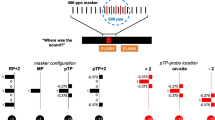Abstract
In cochlear implants (CIs), standard partial tripolar (pTP) mode reduces current spread by returning a fraction of the current to two adjacent flanking electrodes within the cochlea. Symmetric electrode spanning (i.e., separating both the apical and basal return electrodes from the main electrode by one electrode) has been shown to increase the pitch of pTP stimuli, when the ratio of intracochlear return current was fixed. To explain the pitch increase caused by symmetric spanning in pTP mode, this study measured the electrical potentials of both standard and symmetrically spanned pTP stimuli on a main electrode EL8 in five CI ears using electrical field imaging (EFI). In addition, the spatial profiles of evoked compound action potentials (ECAP) and the psychophysical forward masking (PFM) patterns were also measured for both stimuli. The EFI, ECAP, and PFM patterns of a given stimulus differed in shape details, reflecting the different levels of auditory processing and different ratios of intracochlear return current across the measurement methods. Compared to the standard pTP stimuli, the symmetrically spanned pTP stimuli significantly reduced the areas under the curves of the normalized EFI and PFM patterns, without shifting the pattern peaks and centroids (both around EL8). The more focused excitation patterns with symmetric spanning may have caused the previously reported pitch increase, due to an interaction between pitch and timbre perception. Being able to reduce the spread of excitation, pTP mode symmetric spanning is a promising stimulation strategy that may further increase spectral resolution and frequency selectivity with CIs.




Similar content being viewed by others
References
Abbas PJ, Brown CJ, Shallop JK, Firszt JB, Hughes ML, Hong SH, Staller SJ (1999) Summary of results using the nucleus CI24M implant to record the electrically evoked compound action potential. Ear Hear 20(1):45–59
Allen EJ, Oxenham AJ (2014) Symmetric interactions and interference between pitch and timbre. J Acoust Soc Am 135(3):1371–9
Berenstein CK, Vanpoucke FJ, Mulder JJS, Mens LHM (2010) Electrical field imaging as a means to predict the loudness of monopolar and tripolar stimuli in cochlear implant patients. Hear Res 270(1-2):28–38
Bierer JA (2007) Threshold and channel interaction in cochlear implant users: evaluation of the tripolar electrode configuration. J Acoust Soc Am 121(3):1642–1653
Bierer JA (2010) Probing the electrode-neuron interface with focused cochlear implant stimulation. Trends Amplif 14(2):84–95
Bierer JA, Bierer SM, Middlebrooks JC (2010) Partial tripolar cochlear implant stimulation: spread of excitation and forward masking in the inferior colliculus. Hear Res 270(1-2):134–142
Carlyon RP, MacHerey O, Frijns JHM, Axon PR, Kalkman RK, Boyle P, Dauman R (2010) Pitch comparisons between electrical stimulation of a cochlear implant and acoustic stimuli presented to a normal-hearing contralateral ear. J Assoc Res Otolaryngol 11(4):625–640
Cosentino S, Deeks JM, Carlyon RP (2015) Procedural factors that affect psychophysical measures of spatial selectivity in cochlear implant users. Trends Hear 19:1–16
Dingemanse JG, Frijns JHM, Briaire JJ (2006) Psychophysical assessment of spatial spread of excitation in electrical hearing with single and dual electrode contact maskers. Ear Hear 27(6):645–657
Goldwyn JH, Bierer SM, Bierer JA (2010) Modeling the electrode-neuron interface of cochlear implants: effects of neural survival, electrode placement, and the partial tripolar configuration. Hear Res 268(1-2):93–104
Jolly CN, Spelman FA, Clopton BM (1996) Quadrupolar stimulation for cochlear prostheses: modeling and experimental data. IEEE Trans Biomed Eng 43(8):857–865
Landsberger DM, Padilla M, Srinivasan AG (2012) Reducing current spread using current focusing in cochlear implant users. Hear Res 284(1-2):16–24
Litvak LM, Spahr AJ, Emadi G (2007) Loudness growth observed under partially tripolar stimulation: model and data from cochlear implant listeners. J Acoust Soc Am 122(2):967–981
McKay CM (2012) Forward masking as a method of measuring place specificity of neural excitation in cochlear implants: a review of methods and interpretation. J Acoust Soc Am 131(3):2209–24
Mens LHM, Berenstein CK (2005) Speech perception with mono- and quadrupolar electrode configurations: a crossover study. Otol Neurotol 26(5):957–964
Middlebrooks JC, Snyder RL (2007) Auditory prosthesis with a penetrating nerve array. J Assoc Res Otolaryngol 8(2):258–279
Srinivasan AG, Padilla M, Shannon RV, Landsberger DM (2013) Improving speech perception in noise with current focusing in cochlear implant users. Hear Res 299:29–36
Tykocinski M, Saunders E, Cohen LT, Treaba C, Briggs RJS, Gibson P, Cowan RSC (2001) The contour electrode array: safety study and initial patient trials of a new perimodiolar design. Otol Neurotol 22(1):33–41
Vanpoucke FJ, Zarowski AJ, Peeters SA (2004a) Identification of the impedance model of an implanted cochlear prosthesis from intracochlear potential measurements. IEEE Trans Biomed Eng, 51(12): 2174–2183
Vanpoucke F, Zarowski A, Casselman J, Frijns J, Peeters S (2004b) The facial nerve canal: an important cochlear conduction path revealed by Clarion electrical field imaging. Otol Neurotol, 25(3): 282–289
von Bismarck G (1974) Sharpness as an attribute of the timbre of steady sounds. Acustica 30:159–172
Wu CC, Luo X (2013) Current steering with partial tripolar stimulation mode in cochlear implants. J Assoc Res Otolaryngol 14(2):213–231
Wu C-C, Luo X (2014) Electrode spanning with partial tripolar stimulation mode in cochlear implants. J Assoc Res Otolaryngol 15(6):1023–1036
Wu C-C, Luo X (2016) Excitation patterns of standard and steered partial tripolar stimuli in cochlear implants. J Assoc Res Otolaryngol, http://doi.org/10.1007/s10162-015-0549-1
Zhu Z, Tang Q, Zeng FG, Guan T, Ye D (2012) Cochlear-implant spatial selectivity with monopolar, bipolar and tripolar stimulation. Hear Res 283(1-2):45–58
Acknowledgments
We are grateful to all subjects for their participation in the experiments. Research was supported in part by NIH (R21-DC-011844).
Author information
Authors and Affiliations
Corresponding author
Ethics declarations
All subjects gave informed consent and were compensated for their participation. This study was approved by the Purdue IRB committee.
Rights and permissions
About this article
Cite this article
Luo, X., Wu, CC. Symmetric Electrode Spanning Narrows the Excitation Patterns of Partial Tripolar Stimuli in Cochlear Implants. JARO 17, 609–619 (2016). https://doi.org/10.1007/s10162-016-0582-8
Received:
Accepted:
Published:
Issue Date:
DOI: https://doi.org/10.1007/s10162-016-0582-8




